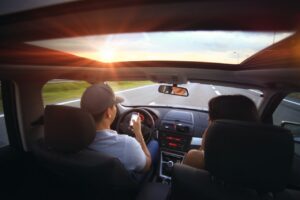When another motorist is speeding, weaving in and out of lanes, tailgating, or engaging in other aggressive driving behaviors, it can irritate other drivers on the road. However, this unsafe and irresponsible driving behavior is also dangerous and can increase the risk of a severe car accident.
Unfortunately, aggressive driving is a common problem among motorists in the United States, particularly when impatient drivers are in a rush, stuck in heavy traffic, or are irritated with another driver. While aggressive driving can cause severe accidents that may result in severe, even life-threatening injuries, these accidents are largely preventable if motorists obey the rules of the road and make safety a top priority.
What Is Considered Aggressive Driving?
According to the National Highway Traffic Safety Administration (NHTSA), aggressive driving occurs when a motorist commits a combination of traffic offenses that endanger other persons or property. The following are common examples of aggressive driving behaviors:
- Speeding
- Driving too fast for the conditions
- Tailgating
- Weaving in and out of traffic
- Running through a stop sign or a red light
- Cutting off other drivers
- Passing where prohibited
- Changing lanes without signaling
- Blocking other drivers who are trying to pass or change lanes
- Failing to yield to a driver that has the right of way
- Aggressive honking
- Illegal driving on a road shoulder, sidewalk, or median
- Sending inappropriate or offensive hand gestures
What Are the Most Common Reasons for Aggressive Driving?
Aggressive driving is unsafe and can endanger the other passengers in the vehicle, as well as other motorists on the road. There is no excuse for driving aggressively, yet it continues to be a common problem on our roads. The following are some of the most common reasons that motorists drive aggressively:
- Impatience: This is the number one cause of aggressive driving accidents. When motorists are impatient and in a rush to get to where they are going, they are more likely to drive too fast or resort to other aggressive driving behaviors to arrive at their destination as soon as possible.
- Stress: This is another common cause of aggressive driving that often affects truck drivers, delivery drivers, and other motorists under pressure to meet tight, often unrealistic delivery deadlines. The stress and anxiety associated with failing to meet the delivery deadline can cause drivers to drive aggressively.
- Anger: Unfortunately, some motorists cannot control their anger when they are behind the wheel. This can increase the risk of a serious accident. Never engage with a driver who appears to be driving aggressively or angrily. In extreme cases, aggressive driving can escalate to road rage.
- Inexperience: When inexperienced teen drivers become overwhelmed, the stress of the situation can cause them to drive aggressively. Teen drivers also learn behaviors from their parents, so if one or both parents drive aggressively while their teens are in the car, they are more likely to emulate this bad behavior.
- Intoxication: When a driver has had too much to drink, their inhibitions are down, which means they may be more likely to become angry or aggressive if they make a mistake, miss a turn, or get cut off by another driver. This behavior, in combination with being intoxicated, can have hazardous consequences.
- Anonymity: When motorists drive at night or in a vehicle with tinted windows where other motorists cannot see the driver, they are more likely to drive aggressively if they know they are not easily identifiable by other nearby drivers.
How Can I Prevent an Aggressive Driving Accident?
Unfortunately, you cannot control how other motorists drive, but you can take some proactive steps to identify an aggressive driver and avoid a potentially serious car accident, including:
- Follow the rules of the road. That means obeying the speed limit, maintaining a safe following distance, allowing other motorists to merge into traffic, using your signal when changing lanes, and using caution when driving in parking lots.
- Manage your behavior. You will likely observe other drivers engaging in unsafe, inconsiderate, and dangerous behavior. Do not respond to those drivers. Put space between you and the aggressive driver, and call 911 if the driver is endangering other motorists.
- Use your horn sparingly. Only tap your horn lightly to get the other driver’s attention. Avoid repeatedly honking your horn, as this can cause an already aggressive driver to become angry and direct that anger at you.
- Avoid making rude gestures. If another driver cuts you off, refuses to let you merge, or sends you a rude hand gesture, you may be tempted to send a rude gesture in return. However, that could worsen the situation and cause the other driver to be even more enraged. Keep your cool, and put space between you and the other driver. If you feel your safety is threatened, drive to the nearest police station, hospital, or fire station.
- Apologize if you did something wrong. If you accidentally cut off another driver or do something that angers another driver, be sure to smile and wave as an apology and avoid doing anything that will cause the situation to escalate.
Dayton Car Accident Lawyers at Wright & Schulte LLC Represent Victims of Aggressive Driving Accidents
If you were injured in a car accident involving an aggressive driver, contact our Dayton car accident lawyers at Wright & Schulte LLC. To schedule a free consultation, call 937-222-7477 or contact us online. Located in Dayton, Ohio, we serve clients in Cincinnati, Columbus, Cleveland, Centerville, Toledo, Youngstown, and Miamisburg.



